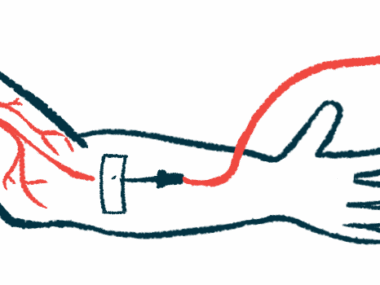Fabry gene therapy improves heart health after 1 to 2 years
4D-310 uses a vector to deliver functional GLA copy to heart muscle cells
Written by |

Measures of heart function improved one to two years after treatment with 4D-310, an investigational gene therapy for Fabry disease, according to new trial data from 4D Molecular Therapeutics (4DMT), the therapy’s developer.
“We are pleased to see 4D-310 continue to consistently demonstrate clinical activity across multiple important cardiac endpoints, including cardiac function, exercise capacity and quality of life,” Robert Kim, MD, chief medical officer of 4DMT, said in a company press release.
The data were presented in a late-breaking session at WORLDSymposium 2024 in San Diego.
Fabry disease is caused by mutations in the GLA gene and result in a deficiency in the alpha-Gal A enzyme, which breaks down fatty molecules, primarily globotriaosylceramide (Gb3 or Gl-3). Without sufficient alpha-GLA, the molecules build up to toxic levels, causing tissue and organ damage, particularly in the kidneys and heart.
Enzyme replacement therapy (ERT) is the standard Fabry treatment and delivers a functional, lab-made alpha-Gal A enzyme into the bloodstream. Despite being able to improve kidney function, ERT doesn’t fully address impaired heart function.
“Current therapies do not adequately address Fabry-related cardiovascular manifestations, and cardiovascular disease is the most common cause of death in these patients,” Kim said.
What does 4D-310 do in Fabry disease?
4D-310 uses a vector called C102 to deliver a functional copy of the GLA gene to heart muscle cells, called cardiomyocytes, with a single low-dose administration into the bloodstream. Designed with 4DMT’s Therapeutic Vector Evolution platform, it restores alpha-Gal A levels through a dual mechanism of action.
The therapy is being tested in two Phase 1/2 clinical trials, one in the U.S. (NCT04519749) and the other in Taiwan and Australia (NCT05629559). So far, six patients have received it.
Early data from the first three U.S. participants showed improvement in measures of heart function a year after treatment. Three patients developed atypical hemolytic uremic syndrome (aHUS), wherein red blood cells are destroyed, however.
Although all recovered within two to four weeks, the company paused enrollment in both trials. Soon after, the U.S. Food and Drug Administration (FDA) placed a clinical hold on the U.S. trial. The Asia-Pacific program continued, however.
Late last year, 4DMT reached an agreement with the FDA to lift the hold and launched a single safety study in nonhuman primates (NHPs) that will assess whether 4D-310 combined with the immunosuppressive medications rituximab and sirolimus (R/S) lowers the risk of aHUS. 4DMT plans to submit the results to the FDA by the end of June.
“We remain on track to submit results from the nonclinical study to evaluate 4D-310 in NHPs with the R/S immunosuppressive regimen to the FDA in Q2 2024 to address the clinical hold,” said David Kirn, MD, co-founder and CEO of 4DMT.
No clinically significant heart or liver toxicities were reported in both trials at the most recent data cutoff on Dec. 5, 2023 and no new treatment-related side effects beyond grade 1 (mild) have occurred in up to 33 months of follow-up.
“4D-310 continues to be well tolerated, with the previously reported cases of aHUS having fully resolved and no new drug-related adverse events over Grade 1 reported,” Kim said.
Gains in heart function, exercise, quality of life
Based on echocardiography assessments, heart ventricle function improved in all five evaluable patients a year after treatment. Two patients who reached a two-year follow-up showed clinically meaningful improvements, with a change of -2.8 % and -2.9%, which exceeds the minimal detectable difference of -1.5%. This was assessed using Global Longitudinal Strain measurements, a method that focuses on measuring the contraction of the heart muscle fibers.
Three of four evaluable patients showed clinically meaningful improvements in exercise capacity, as assessed by peak VO2, or the highest amount of oxygen consumed at peak exercise, a year after treatment (+1.8, +2.0, and +7.0). One participant who reached the two-year follow-up continued to show an improvement of +7.8%.
Heart-related quality of life remained stable or improved after treatment, as assessed using the Kansas City Cardiomyopathy Questionnaire. Two patients with low scores before treatment saw meaningful improvements in quality of life, while three remained stable between one and two years.
Cardiac biopsies of one patient after six and 26 weeks showed durable treatment-related activity of the delivered functional GLA gene (transgene), with all samples positive for the alpha-Gal A enzyme. Mean levels of Gb-3 dropped by 15% between six and 26 weeks, and 61% compared with a historical sample collected about seven years before the study.
“Cardiac biopsies also showed robust and durable delivery and transgene expression from 4D-310, and remarkably, a reduction in Gb3 substrate in cardiomyocytes,” Kirn said. “No approved therapy has been shown to definitively clear accumulated Gb3 from cardiomyocytes in patients with Fabry disease. These promising clinical results continue to validate our Therapeutic Vector Evolution platform, as well as the potential of the C102 vector for targeted [into-the-vein] delivery to cardiomyocytes.”





